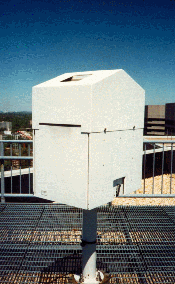Cloud
Height Sensor
(CEILOMETER)
 The
Cloud Height Sensor (the ceilometer), determines cloud height and levels in
the atmosphere. The ceilometer (pronounced se-lom'-i-ter) uses invisible laser
radiation to detect cloud levels. The ceilometer works by transmitting a pulse
of laser light into the atmosphere and sensing the light return as it is
reflected back toward the ceilometer by objects in its path. By timing the
interval between the transmission and reception, the height of particles (such
as water droplets or ice crystals in clouds) above the ceilometer is calculated
and reported to the Data Collection Package (DCP).
The
Cloud Height Sensor (the ceilometer), determines cloud height and levels in
the atmosphere. The ceilometer (pronounced se-lom'-i-ter) uses invisible laser
radiation to detect cloud levels. The ceilometer works by transmitting a pulse
of laser light into the atmosphere and sensing the light return as it is
reflected back toward the ceilometer by objects in its path. By timing the
interval between the transmission and reception, the height of particles (such
as water droplets or ice crystals in clouds) above the ceilometer is calculated
and reported to the Data Collection Package (DCP).
The ceilometer measures how much time it takes a pulse of light to travel from the Ceilometer Transmitter, through the atmosphere, to reflect off a cloud, and to return to the Ceilometer Receiver. The distance traveled by a light pulse can be calculated, by starting a timer when the transmitter sends out a pulse of light and by stopping the timer when the receiver detects the return of the reflected pulse. Because the total distance traveled includes a path from the transmitter to the cloud and back again, the actual height of the cloud (from the transmitter) is one-half of the total distance. The calculation is expressed as: